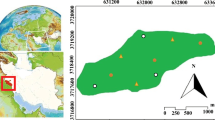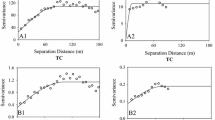Abstract
In recent years, the relationship between biodiversity and ecosystem stability, productivity, and other ecosystem functions has been extensively studied by using theoretical approaches, experimental investigations, and observations in natural ecosystems; however, results are controversial. For example, simple systems were more stable than complex systems in theoretical studies, and higher productivity was observed in human-made ecosystems with poorer species composition, etc. The role of biodiversity in the ecosystem, such as its influence on sustainability, stability, and productivity, is still not understood. Because accelerated soil-erosion in various ecosystems has caused a decrease of primary productivity, a logical way used in the study of the relationship between biodiversity and ecosystem function can be used to study the relationship between plant species diversity and soil conservation. In addition, biodiversity is a product of evolutionary history, and soil erosion is a key factor controlling the evolution of modern environment on the surface of the Earth. A study on the relationship between biodiversity and soil-erosion processes could help us understand the environmental evolution of Earth.
Fifteen 10 m × 40 m standard runoff plots were established to measure surface runoff, soil erosion, and total P loss in different secondary communities of semi-humid evergreen broad-leaved forests that varied in composition, diversity, and level of disturbance and soil erosion. The following five communities were studied: AEI (Ass. Elsholtzia fruticosa + Imperata cylindrical), APMO (Ass. Pinus yunnanensis + Myrsine africana + Oplismenus compsitus), APLO (Ass. Pinus yunnanensis + Lithocarpus confines + Oplismenus compsitus), AEME (Ass. Eucalyptus smith + Myrsine africana + Eupatorium adenophorum), and ACKV (Ass. Cyclobalanopsis glaucoides + Keteleeria evelyniana + Viola duelouxii). Tree density, the diameter of the tree at breast height, and the hygroscopic volume of plant leaves were determined in each plot.
Results indicated that surface runoff, soil erosion, and total P loss decreased as a power function with increase in plant species diversity. Their average values for three years were 960.20 m3/(hm2 · year), 11.4 t/(hm2 · year), and 127.69 kg/(hm2 · year) in the plot with the lowest species diversity, and 75.55 m3/(hm2 · year), 0.28 t/(hm2 · year), and 4.71 kg/(hm2 · year) in the plot with the highest species diversity, 12, 50, and 25 times respectively lower compared with the lowest species diversity plots. The coefficients of variation of surface runoff, soil erosion, and total P loss also followed a power function with the increase of plant species diversity, and were 287.6, 534.21, and 315.47 respectively in the lowest species diversity plot and 57.93, 187.94, and 59.2 in the highest species diversity plot. Enhanced soil conservation maintained greater stability with increased plant species diversity. Plant individual density increased linearly and the canopy density and cross section at breast height increased logarithmically with the increase of plant species diversity. The hydrological function enhanced as the plant species diversity increased. There were obviously relationships between plant species diversity and rainfall interception, coverage, and plant individual density, which was related to soil conservation functions in the five forest communities.
The complex relationships between plant species diversity and the above-mentioned ecological processes indicated that plant species diversity was an important factor influencing the interception of rainfall, reducing soil erosion and enhancing the stability of soil conservation, but its mechanism is not known. This experiment showed that plant species diversity promoted soil and nutrient conservation and ultimately lead to the increase of the primary productivity of the ecosystem, and was thus a good way to study the relationship between biodiversity and ecosystem stability. Rainfall interception could be assessed easily using the hygroscopic volume of plant leaves. Because there were strong correlations between plant species diversity and soil conservation functions, the patterns of plant species diversity will show a certain level of predictability on the interactions of life systems with surface processes of the Earth.
Similar content being viewed by others
References
Chen L Z, Qian Y Q (1997). Frontiers in biodiversity science. Acta Ecol Sin, 17(6): 565–572 (in Chinese)
Ewel J J (1986). Designing agricultural ecosystems for the humid tropics. Annu Rev Ecol Syst, 17: 245–254
Ewel J J, Mazzarino M J, Berish C W (1986). Tropical soil fertility changes under monoculture and successional communities of different structure. Ecol Appl, 1: 289–302
Feng Y Z (2003). Species diversity and manmade forest ecosystem stability. Chin J Appl Eco, 14: 853–857 (in Chinese)
Feng Z W (1999). Biomass and Primary Productivity of Chinese Forest Ecosystems. Bei**g: Science Press, 1–157 (in Chinese)
Huang J H (1995). Biodiversity and ecosystem stability. Chin Biodivers, 3(1): 31–37 (in Chinese)
Huang J H, Bai Y F, Han X G (2000). Effects of species diversity on ecosystem functioning: mechanisms and hypotheses. Chin Biodivers, 9: 1–7 (in Chinese)
Huston M A, Aarssen L W, Austin M P, Cade B S, Fridley J D, Carnier E, Grime J P, Hodgson J (2000). No consistent effect of plant diversity on productivity. Science, 289: 1,255
Jiang H Q (1984). Several issues in researching about Yunnanesis pinus. J Yunnan Univ, 6(1): 1–5 (in Chinese)
Jiang Y X, Wang B S, Zang R G, ** J H, Liao W B (2002). Biodiversity and Formation Mechanism of Tropical Forest in Hainan Island in China. Bei**g: Science Press, 217–233 (in Chinese)
Kareiva P (1996). Diversity and sustainability on the prairie. Nature, 379: 673–674
Liu W Y, Liu L H, Zhang Z, **g G F (1991). Preliminary study on hydrological function of evergreen broad-leaved forest and Pinus yunnanensis forest in central Yunnan Province. Acta Phytoecol Geobot Sin, 15: 159–167 (in Chinese)
Liu S R (1996). Reviews on the interception function of forest ecosystem-global water cycle, water resources and crisis. In: Jiang Y X, ed. The Law of Forest Ecosystem Structure and Function in China. Bei**g: China Forestry Publishing House, 16–22 (in Chinese)
Loreau M, Naeem S, Inchausti P, Bengtsson J, Grime J, Hedtor A, Hooper D, Huston M, Raffaelli D, Schmid B, Tilman D, Wardle D (2001). Biodiversity and ecosystem function: current knowledge and future challenges. Science, 294: 804–808
Ma K P, Mi X C, Wei W, Lu Z J (2004). Advances and review on biodiversity. In: Li W H, Zhao J Z, eds. Recall and Prospect on Ecology. Bei**g: China Meteorological Press, 110–125 (in Chinese)
May R M (1973). Stability and Complexity in Model Ecosystem. Princeton: Princeton University Press, 108–110
McCann K, Hastinges A, Huxel G (1999). Weak trophic interactions and the balance of nature. Nature, 295: 794–798
Naeem S, Thompson L J, Lawler S P, Lawton J H, Woodfin R M (1994). Declining biodiversity can alter the performance of ecosystem. Nature, 368: 734–737
Purvis A, Hector A (2000). Getting the measure of bio-diversity. Nature, 405: 212–219
Schlesinger W H (1977). Biogeochemistry: an Analysis of Global Change. San Diego: Academic Press, 5–50
Schlesinger W H (1997). Carbon balance in terrestrial detritus. Ann Rev Ecol Syst, 8: 51–81
Schulze E D, Mooney H A (1993). Biodiversity and Ecosystem Function. New York: Springer-Verlag, 1–54
Song Y C (2001). Vegetation Ecology. Shanghai: Eastern China Normal University Press, 52 (in Chinese)
Spehn E M, Joshi J, Schmid B, Diemer M, Komer C (2000). Above-ground resource use increases with plant species richness in experimental grassland ecosystem. Funct Ecol, 14: 326–337
Tilman D (1996). Bio-diversity: population versus ecosystem stability. Ecology, 77: 350–263
Tilman D, Wedin D, Knops J (1996). Productivity and sustainability influenced by bio-diversity in grassland ecosystems. Nature, 379: 718–720
Wang D L, Ba L, Wang Y Q (2004). Advances and prospect on theory ecology. In: Li W H, Zhao J Z, eds. Recall and Prospect on Ecology. Bei**g: China Meteorological Press, 3–27 (in Chinese)
Wang L X (1997). Soil and Water Conservation. Bei**g: China Forestry Publishing House, 139–141 (in Chinese)
Wang Z H, Zhang L, Duan C Q (2001). Relationship between manmade forest community structure and soil erosion in Muding County of Yunnan Province. Res Soil Water Conerv, 8(2): 74–79 (in Chinese)
Wardle D, Zackrisson O, Homberg G (1997). The influence of island area on ecosystem properties. Science, 277: 1,296–1,299
William J R, Renard K G, Dyke P T (1983). EPIC-a new method for assessing erosion, effect on soil productivity. J Soil Water Conserv, 36: 381–383
Yue T X, Ma S J (1991). The study on ecosystem stability. Acta Eco Sin, 11: 361–366 (in Chinese)
Zhang D Y (2001). Research on Theory Ecology. Bei**g: Higher Education Press, 1–100 (in Chinese)
Zhang Q G, Zhang D Y (2002). Biodiversity and ecosystem functioning: recent advances and controversies. Bio Sci, 10: 49–60 (in Chinese)
Zhou G Y (1997). Principal and Application of Water and Heat in Ecosystem. Bei**g: China Meteorological Press, 25–74 (in Chinese)
Zhou J Z, Ma S J (1990). Ecosystem stability. In: Ma S J, ed. Perspective of Modern Ecology. Bei**g: Science Press, 54–71 (in Chinese)
Zhu T C, Zhong Z C, Li J D (1988). Plant Ecology. Bei**g: Higher Education Press, 198–199 (in Chinese)
Author information
Authors and Affiliations
Corresponding author
Additional information
__________
Translated from Journal of Plant Ecology, 2006, 30(3): 392–403 [译自: 植物生态学报
About this article
Cite this article
Wang, Z., Yang, C., Yang, L. et al. Relationship and its ecological significance between plant species diversity and ecosystem function of soil conservation in semi-humid evergreen forests, Yunnan Province, China. Front. Forest. China 2, 18–27 (2007). https://doi.org/10.1007/s11461-007-0003-6
Issue Date:
DOI: https://doi.org/10.1007/s11461-007-0003-6




